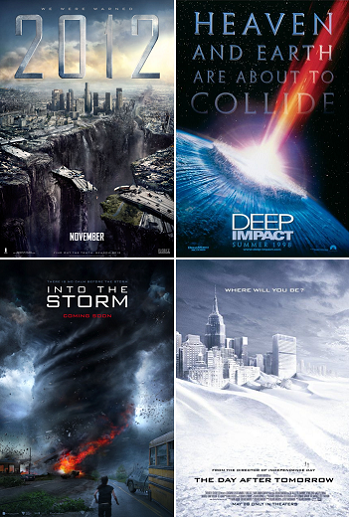
We’ve all seen or heard of at least one natural disaster movie. There are so many of them out there! These films thrust characters into situations where surviving seems nearly impossible. The characters must implement certain tactics to try to survive. These movies are usually very intense, contain lots of action and drama, but how realistic are natural disaster movies compared to real-life scenarios?
Do these films contain useful survival techniques in emergencies that happen in the real world? What can we, as an audience, learn from natural disaster movies if we were to find ourselves ever in such an extreme situation? Read on to find out how natural disaster movies compare to real natural disasters.
What Are Natural Disaster Movies?
A Natural Disaster movie is a genre of film that involves an ongoing or impending disaster scenario. These films can include natural disasters such as tsunamis, floods, earthquakes, space debris collision, pandemics, tornados or tidal waves. The plots usually center around a group of characters preparing for the oncoming disaster or what happens after the disaster has already occurred. Natural disaster movies usually depict characters who have been thrust into an awful scenario, usually involving an accident that has occurred due to a natural disaster.
The characters must implement certain tactics to survive. The featured characters must avoid, outrun, escape or find other means of survival depending on which type of catastrophe they find themselves in. Often, natural disaster films can focus on the natural disaster from several points of view, showing various versions of the scenario. The focus is the survival of the characters and their means to live through whatever natural disaster is occurring.
The plot of disaster movies always shows varying methods of survival used by different characters and the extreme, sometimes terrible means people will attempt to survive. There are tons of natural disaster movies, some that deal with possible scenarios and some that deal with highly unlikely ones. These films have truly created a genre of their own, sometimes referred to as “Survival movies.” Most of these films feature large-scale depictions of disasters and build suspense throughout the storyline.
Some examples of natural disaster movies are Geostorm (2017), Cabin Fever (2002), Everest (2015), San Andreas (2015) and Armageddon (1998).

How Do They Differ from Real Disasters?
To explain how natural disaster movies are different from real life disasters, let’s take a look at some main, plausible natural disasters that could happen to us in real life. In the movies, these scenarios occur quick, which likely would not be the case. But to break it down, here are some main scenarios featured in the movies and how they would differ in real life.
Weather-Related Natural Disasters

In movies such as “Geostorm” and “The Day after Tomorrow,” we see extreme weather that takes place everywhere due to global warming. The freak weather begins, and characters are forced to flee to a safe zone or seek shelter. In these movies, there are always people who underestimate the catastrophe they are about to experience. Most emergency services in these natural disaster movies aren’t available to the characters, and they usually team up with others to organize a plan for survival.
In “The Day after Tomorrow,” the temperature rapidly drops by the second actually freezing all living things immediately as it sweeps through areas. In these types of natural disaster films, the weather is so extreme that sinkholes come out of nowhere, aircraft cannot fly due to rapid winds, and it all occurs in only a few days, forcing the characters to act very quickly, usually risking their lives to evacuate or hunker down.
In real life, however, this type of natural disaster wouldn’t play out this way. It isn’t too far of a stretch to believe that freak weather wouldn’t occur during this type of disaster. Emergency services would be delayed, and all public transit would likely cease to be available. Extreme flooding could occur quite quickly, but it’s unlikely that such large-scale freak weather would occur everywhere, as it’s depicted in the movies. The movies never show emergency warning systems being enacted until the last minute, which likely wouldn’t be the case, giving people more time to react to an impending disaster.
Pandemics
In natural disaster movies relating to infectious disease or pandemics, it shows rapidly spreading viruses such as the popular “zombie” concept. Horror flicks like “Cabin Fever” show a skin-eating disease spreading quickly through contact and the water supply. Any disease film shows a single cough, a handshake or a sip of water causing unbelievable consequences that lead to pure chaos. Characters in these movies gather weapons, group together and do whatever they can to fight back against becoming one of the diseased. In the movies, society and all protocols break down within days of a virus being unleashed.
A real-life pandemic would be immediately addressed by the CDC, who do have protocols in place for pandemic scenarios. They also have backup plans in real life. Most organizations have plans set for this type of scenario where vaccines would be administered quickly, and the diseased would be quarantined from the rest of the population. It wouldn’t be immediate chaos and would be addressed by various organizations as soon as a virus would become known. Preventative measures are also in play in the real world that would cause this type of natural disaster not to be apocalyptic as the movies depict.
Other Natural Disaster Movies & Real Life Differences

With most natural disasters, there are organizations and protocols in place. Earthquakes, for example, would be detected early, giving people time to evacuate. It wouldn’t occur the way it did in the movie “San Andreas,” where the Rock essentially saves everyone. Emergency services would be available, and the National Guard would respond quickly.
Natural disaster movies show a very exaggerated version of “what-ifs,” and most of the time are not accurate to what would really occur. Some aspects of these films do show good methods of survival. For example, in virus-related movies, people usually separate from others, which would obviously be a good move. In the movie “Twister,” people seek shelter for the oncoming tornado. The largest difference between natural disaster movies and real life is that in reality, we have warnings before these events and organizations are prepared for natural disaster scenarios.
What Can Be Learned from These Movies?

There is some value in what characters do in certain natural disaster movies. Seeking shelter from a natural disaster, for example, is the right move. In the event of tornados, the characters go underground. Characters who are in a situation such as flooding, hurricanes, landslides or volcanic explosions evacuate the affected area, which is what should be done in real life.
In a lot of these natural disaster movies, we often see characters who have prepared for a disaster to take place. They have water and food stored and sometimes even have a shelter to shield them from outside disasters. Being prepared for a natural disaster is a good idea. Scenarios that would lead to long-lasting power outages, water-line breaks, and other similar emergencies do occur. Having certain items in your home in case of an emergency is smart. Things like flashlights, candles, water, spare food, and basic first aid supplies would be helpful in most, realistic natural disaster scenarios.
Natural disaster films depict highly exaggerated versions of natural disasters, but that doesn’t mean that some of what the characters do to survive wouldn’t be useful in real life. Along with having items prepared in case of an emergency, it’s a good idea for people to know basic first aid measures such as cleaning and bandaging wounds, CPR and means to keep the body warm. Knowing certain survival techniques, having a list of emergency numbers on hand and having a basic means of defense would be helpful in many real-life natural disaster scenarios.
Conclusion
Natural disaster movies are fast-paced films that build the excitement and show a rapid disaster occurring in a very unrealistic manner, usually for entertainment purposes. This doesn’t mean that some of what the characters do to survive wouldn’t be plausible to do in a real-life scenario. The main takeaway from natural disaster movies is the idea of being prepared for a natural disaster that could occur where you live.
Evacuating during a natural disaster versus sheltering in place would be two options, depending on the type of natural disaster that is happening. Knowing when to shelter in place and when it’s time to leave the area are the best measures that are depicted in these films.

